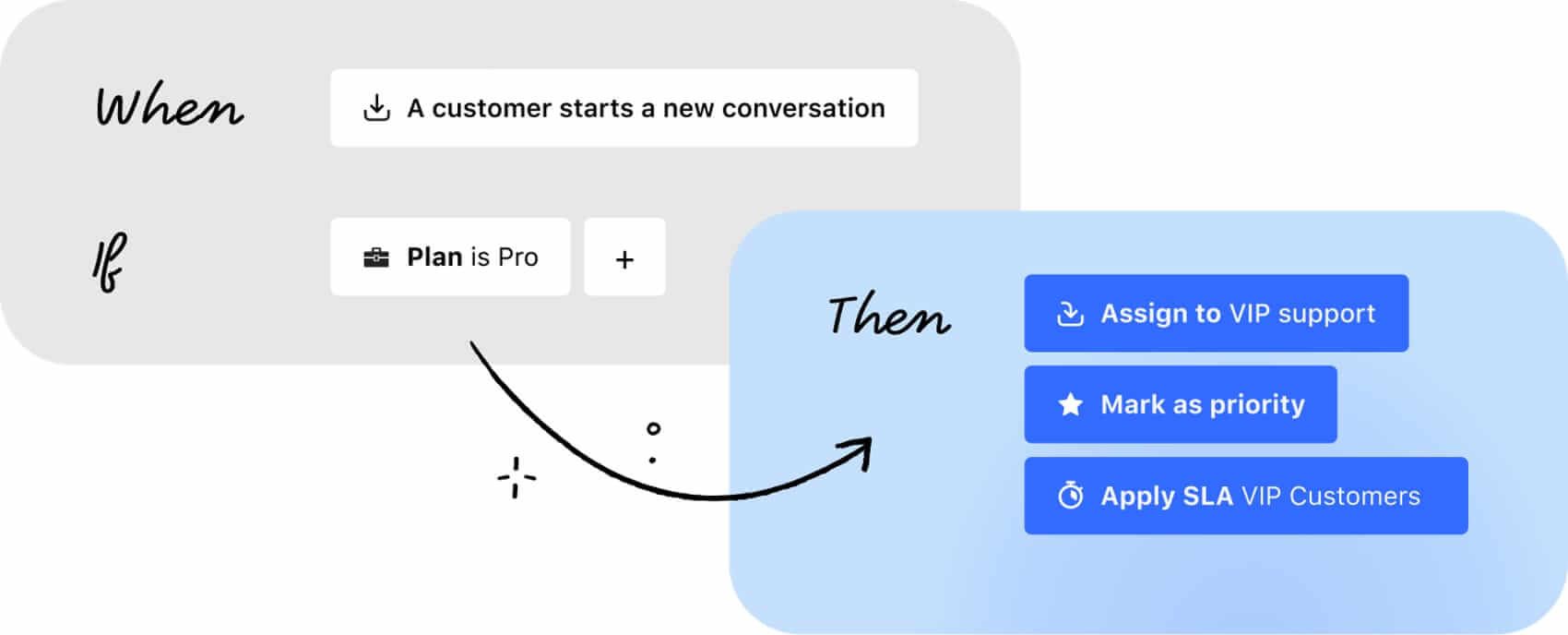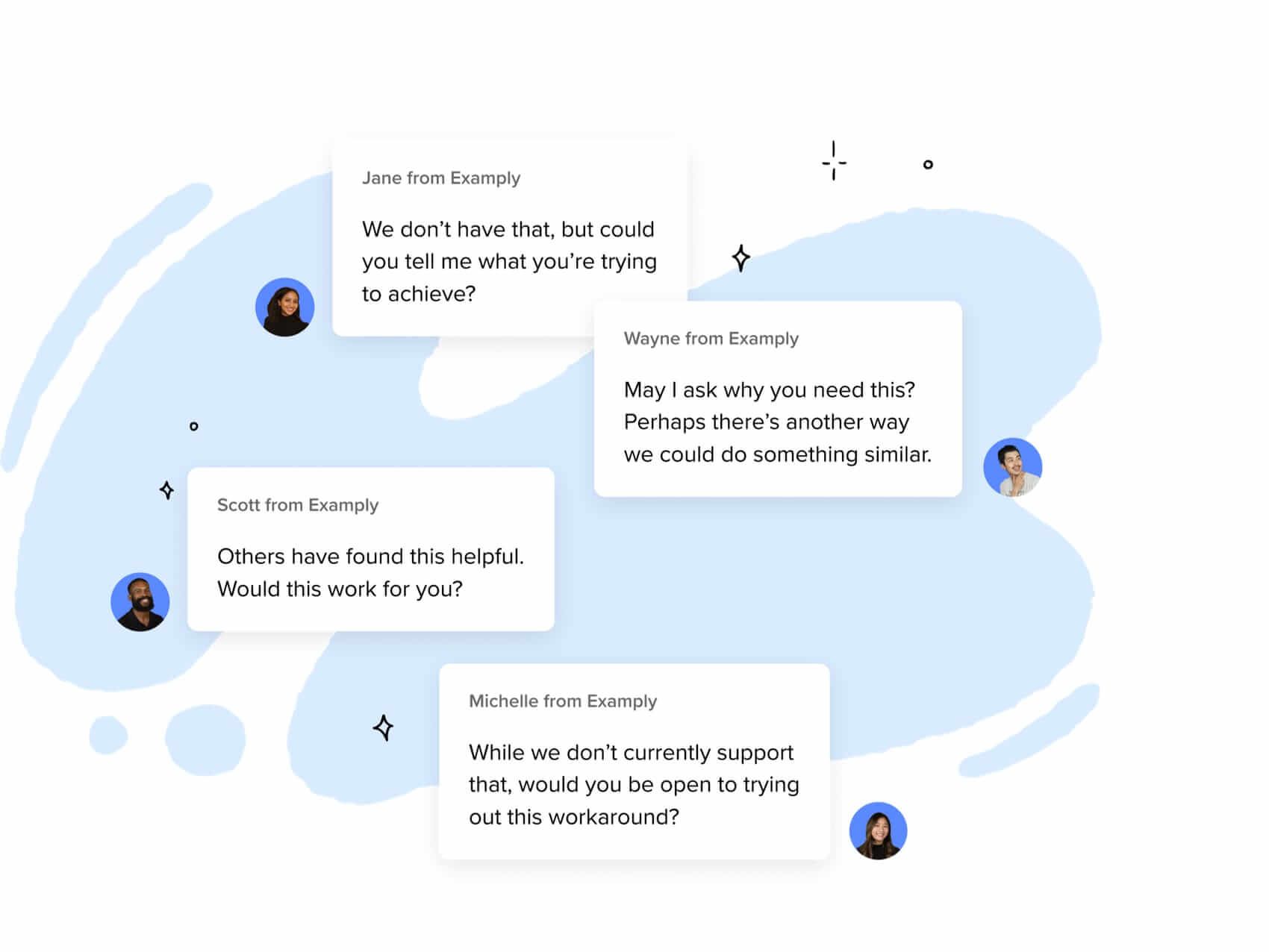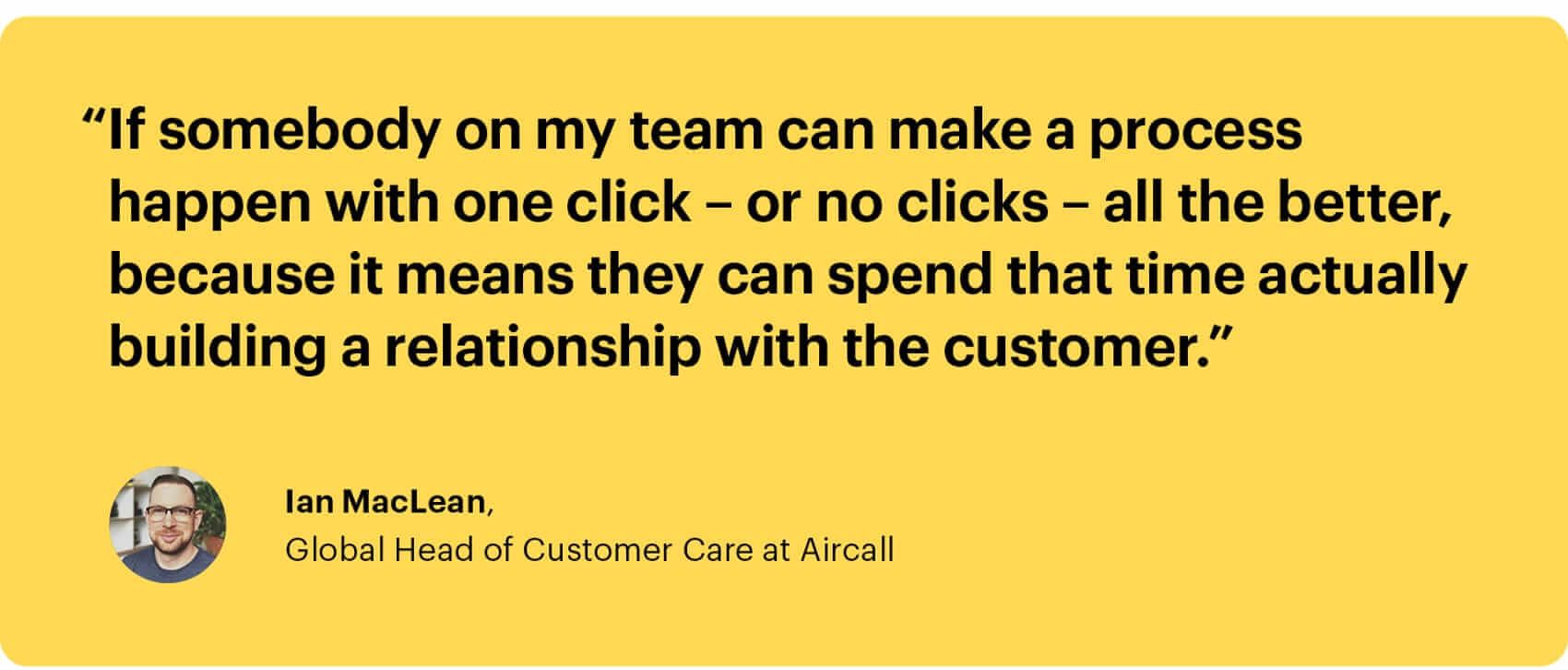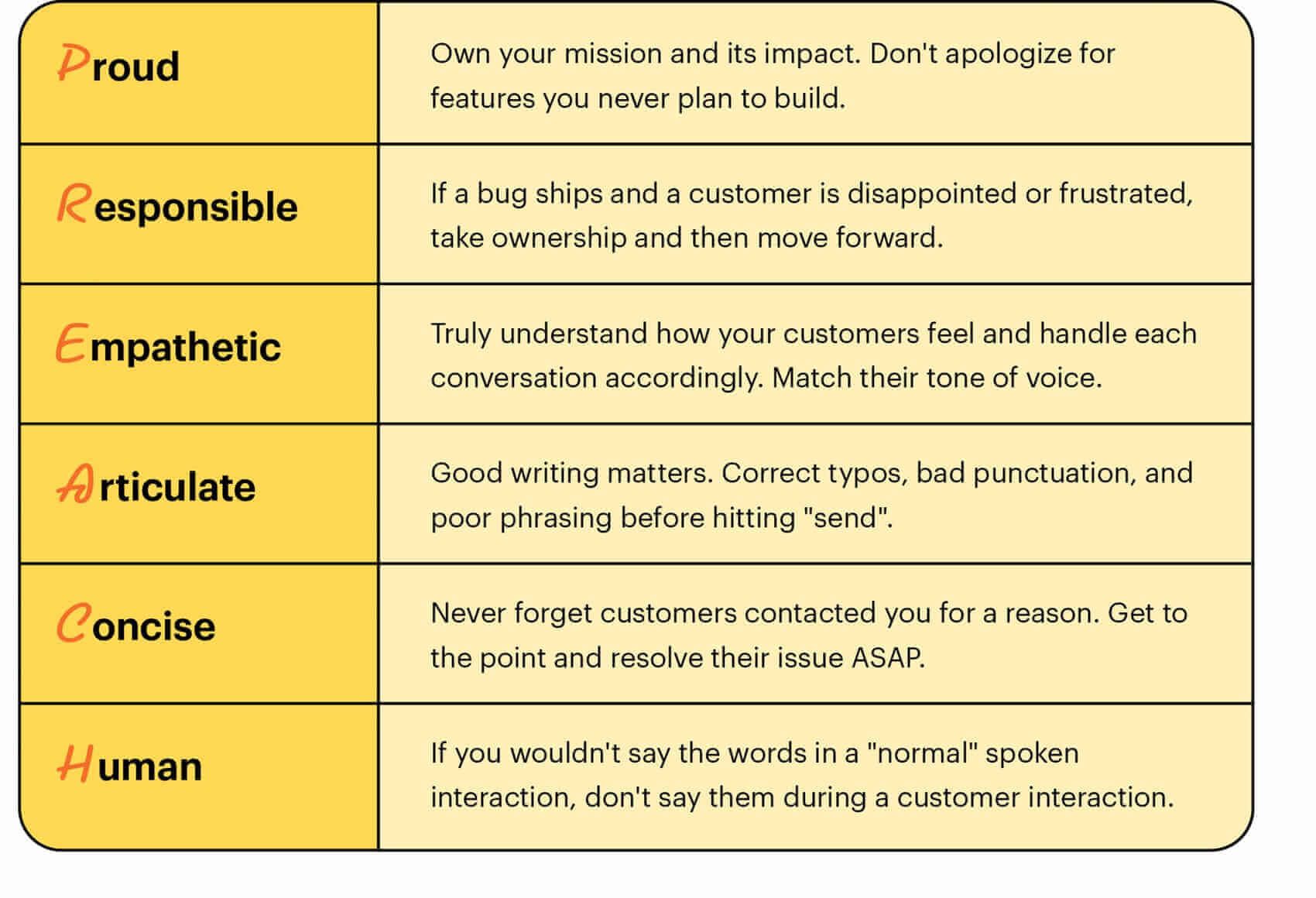
The support leader’s guide to personal, efficient human support
Today, customers’ expectations for fast, personal support are higher than ever – making automation essential for resolving simple, repetitive queries at scale. But there’s an inescapable fact that not every answer can, or should, be automated.
After all, not even the best chatbot can help calm an angry customer, investigate a thorny issue, or build rapport with high-value customers quite like your team can. These types of issues require an empathetic, human touch.
Human support is an essential part of any successful support strategy, but the reality is that it doesn’t scale and it’s expensive to operate. It’s also a waste of your support team’s expertise and resources if they need to answer every question that rolls in – regardless of each issue’s priority, how urgent it is, or how much the customer is spending with you.
So how do you empower your team to be both highly efficient and hyper-personal so they can meet and exceed the demands of modern customers? Below, we share a proven framework and powerful workflows for freeing up your support team’s workload and ensuring only the most high-value, complex queries reach their inbox. We’ll also dive into effective support principles for resolving high-touch queries with empathy, transparency, and speed.
Ensure only complex queries reach your team
At Intercom, we use a framework called the Support Funnel to deliver efficient, personal support to our customers. It combines proactive, self-serve, and human support capabilities to get ahead of known problems before they arise, automatically answer repetitive queries, and quickly resolve complex issues.
With the funnel, proactive and self-serve support resolve most simple, repetitive queries, meaning only the most complex and critical issues ever reach your team.
When most of your customers’ questions are resolved proactively and automatically, it frees up your support team to focus on your most important, complex, and VIP support queries. This also empowers your team to do what they do best – using their product knowledge, technical expertise, and empathy skills to keep customers satisfied and ensure they’re getting long-term value from your product or service.
“By freeing them up to do more of the work they love, you’ll also boost job satisfaction and team morale”
Plus, most support reps don’t enjoy answering the same simple questions over and over – instead, they get a kick out of the kind of work that requires flexing their deep problem-solving skills. By freeing them up to do more of the work they love, you’ll also boost job satisfaction and team morale.
Supercharge your team efficiency with automation and apps
Your support team may appear to possess superhero powers, like the ability to calm angry customers, translate technical issues into easy-to-understand solutions, and solve complex problems. But they’re still human, and being human comes with productivity limits. Some of your biggest efficiency gains won’t come from the hands of your support reps at all, but from the backend of a well-oiled, automated inbox.
It’s worth making your workflows as efficient as possible. Taking mundane, repetitive tasks off your team’s hands will add more fuel to their tank and leave them with more time to better support your customers. Here are some powerful foundational steps to take:
Automate your inbox workflows
“Can I put you on hold?” “Let me pass you to my colleague.” If you’ve ever been on the receiving end of this type of ping-pong support as a customer, you’ll know how frustrating it is to be passed from rep to rep. It wastes both the agent’s and the customer’s time.
“Set up a workflow that automatically collects conversation data from your customer on what their query is about”
A far more efficient (and polite) approach is to set up a workflow that automatically collects conversation data from your customer on what their query is about – whether that’s a billing query, a technical issue, or something else. Then route the conversation to the right team, like your billing team, so they can step in and provide the customer with a speedy, empathetic response.
This also means your team won’t have to spend time manually tagging conversations to identify common customer pain points for your proactive support.

Prioritize VIP and urgent conversations
When a VIP customer gets in touch, you’ll want to fast-track the issue to your VIP team so they can reply ASAP. With a modern customer support tool, like Intercom, you can apply multiple automated rules within each workflow. For example, you can mark these pressing issues as priority and apply an SLA rule to hold your team accountable to delivering a top quality, rapid response.

Seamlessly manage all of your tools from one inbox
A whopping 68% of support leaders say their team hit roadblocks once a month because their support stack isn’t integrated with technology used by other teams. What’s more, the majority of support teams have between six and 10 tools in their support tech stack alone. Imagine how many wasted hours your team is racking up switching between all these tools, not to mention the headaches.

Whatever tools you’re using – whether that’s social media, call center, issue management, or even sales tools – you’ll want to make sure your customer support tool can plug into and play nicely with them. Ultimately, this will make your support more efficient, powerful, and all-around more helpful for customers.
“With Intercom, there are lots of useful apps you can integrate with and use right from the Inbox to streamline your support”
With Intercom, there are lots of useful apps you can integrate with and use right from the Inbox to streamline your support. For example:
- You can connect with your favorite tools, such as Github, Stripe, Shopify, and Salesforce, to take key actions and view third-party data right from the Inbox. That means you can get further context on issues, check in on order statuses, manage subscriptions, process payments, and lots more – all without switching to another app and potentially losing context.
- The Aircall app lets you start a quick phone call with a customer from the Inbox. It provides a fast, easy, and delightful experience for your customers too as they can join the call directly from the Messenger.
- Twitter and Facebook apps automatically pull your direct messages into the Inbox. Instead of your team spending large chunks of their day frequently checking social media channels, they can manage these conversations right from the Inbox too.
5 principles for an empathetic, human response
Of course, speed is just one part of a great customer experience equation. The other part is helping your support team provide a personal, authentic, and genuinely helpful response to every customer they interact with. For this, we recommend creating a set of guiding principles your team can use as their customer support North Star. Here are some of our favorite principles we use at Intercom:
1. Be personal
Nothing says “I don’t value your business” like a canned, generic response. With modern support tools, you can quickly view rich context about each customer, like what company they work for, what plan they’re on, and whether they’ve been in touch before with a similar issue. These personal details can help you quickly understand who the customer is and what they need, without asking lots of introductory questions. Then, you can use these details to resolve the issue in a faster, more empathetic way.

2. Explain things in multiple ways
Different ways of communicating resonate with different people. Be prepared to explain the same thing in a bunch of different ways – in a bulleted list, with a GIF, emoji, or a well-annotated screenshot. However you choose to help your customers, make sure you show, rather than just tell. It’s a great way of illustrating “how-tos” in your product.
3. Know your product or service inside out
When new features are being added, or old ones removed, your product knowledge becomes stale a lot quicker than you think. You should be an up-to-date encyclopedia of knowledge about how your product or service works and what it’s capable of. Partner with your product team to understand new releases ahead of time.
4. Don’t just “address” issues, resolve them
Reaching resolution means that the customer is satisfied – whether you’ve solved their problem or not. Don’t avoid difficult conversations, or say no without any explanation. Saying yes to every request only leads to mistrust between customers and your business. When a customer trusts you’ve considered their problem and given them an honest response, you’ll reach resolution far quicker.

5. Watch your tone with the PREACH framework
Often in life, it’s not what you say, but how you say it, that makes all the difference. Getting your company’s tone of voice just right is incredibly important, especially when you’re dealing with a tricky or emotionally-charged conversation. At Intercom, we use the PREACH tone of voice framework to ensure we’re consistently providing customers with the fast, personal, and transparent support they deserve.
Metrics for championing and enhancing your team’s success
Peter Drucker said it best: “If you can’t measure it, you can’t improve it.” The same goes for your customer support strategy. While there are infinite metrics you could track and tweaks you can make, it’s important to identify what business outcomes you’re trying to solve for, up front. That will help you ensure you’re making and measuring the most impactful wins for your team. Here are our tips:
Set meaningful metrics that move the needle
With the Support Funnel, you’ll be able to achieve high levels of efficiency and an enjoyable, personalized customer experience. This leaves your team with more time to focus on high-value conversations, like stopping customers from churning, helping VIP customers achieve success with your product, and solving deep technical issues. In short, you’ll have more time to focus on proactively growing the business’s bottom line.
“Rather than solely focusing on costs, it pays to target business outcomes that help you move from a ‘cost center’ to a value driver”
Rather than solely focusing on costs, it pays to target business outcomes that help you move from a “cost center” to a value driver like:
- Customer loyalty
- Customer retention
- Customer renewals
Track efficiency gains
Once you’ve implemented the funnel, you’ll also want to see how it’s improving your team’s productivity over time. We recommend setting a benchmark you can track progress toward for key metrics like:
- Rate of new inbound conversations
- Median first response rate
- Median time to close rate
- SLA performance hit rates
Learn, iterate, improve!
Support metrics on their own are just numbers on a dashboard. They only become meaningful when you dig deeper, start looking for underlying trends and themes, and use those insights to take the next step toward making your human support even more personal and efficient. For example, you’ll want to:
- Measure your CSAT (customer satisfaction rating) and ask: “As our company and customer base grows, are we still maintaining a high customer satisfaction rating?” Monitoring this figure over time will let you know how successfully you’re meeting your customer expectations. It’s also a crucial leading indicator of future churn and customer retention. If your CSAT is dipping, it’s important to identify why so you can course correct – for example, if you’re an Intercom customer, you can dive into the messages behind your lowest conversation ratings to understand where you can improve.
- Monitor your team’s efficiency over time, especially as your company and customer base scales. For example, as you receive more queries, do your wait times and/or conversation close times increase? That’s a sign you should lean even more into the Support Funnel and identify which simple, repetitive queries can be resolved automatically and proactively.
Get the full strategy for delivering fast, personal support at scale
Personalized, one-on-one human support is incredibly powerful, but it’s only one piece of the puzzle for delivering fast, personal support to your customers at the scale your business needs. Get the Ultimate Guide to Conversational Support to learn how to combine proactive, self-serve, and human support to achieve world-class support – without burning out your team or budget.
Better customer relationships and a happier, more productive team await👇









